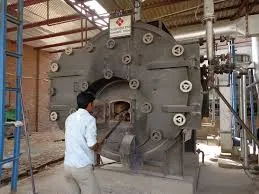
Sen . 19, 2024 19:20 Back to list
hot water boiler temp settings
Understanding Hot Water Boiler Temperature Settings
Hot water boilers are essential components in many residential and commercial heating systems. They provide hot water for various applications, including heating spaces and supplying domestic hot water. One critical aspect of operating a hot water boiler efficiently is setting the correct temperature. Proper temperature settings can enhance efficiency, improve comfort, and prolong the life of the boiler.
The first thing to consider when setting the temperature of a hot water boiler is the specific needs of your household or facility. Generally, the temperature settings for domestic hot water usually range between 120°F to 140°F (49°C to 60°C). For most residential applications, 120°F is adequate for safe and comfortable hot water use. This temperature helps prevent scalding while providing sufficient heat for bathing, cooking, and cleaning. However, some households might prefer a slightly higher setting, especially if they have larger demands for hot water.
In commercial settings, the temperature might need to be adjusted based on the type of business. For instance, restaurants might require hotter water for sanitation purposes, sometimes setting the boiler to around 160°F (71°C) to ensure that dishwashing and sanitizing processes meet health and safety regulations. It’s essential to assess these needs carefully to ensure that the boiler operates efficiently without wasting energy.
hot water boiler temp settings

Another factor to consider is the seasonal temperature variation. During colder months, you might need to raise the temperature setting to ensure adequate heating and comfort. Conversely, you may lower the temperature during warmer months to save on energy costs. Modern smart thermostats can help automate these adjustments, maintaining optimal temperature settings based on usage patterns and outdoor temperatures.
Additionally, periodically checking and maintaining the boiler is crucial. Over time, sediment can build up in the tank, affecting efficiency and performance. Regular maintenance can help keep the temperature settings accurate and ensure that the boiler is working at its best.
Safety should always be a priority. Ensure that your boiler has the appropriate safety devices, such as pressure relief valves and temperature sensors, to prevent overheating and pressure buildup. Consulting a professional technician for installation and periodic checks can help mitigate risks.
In conclusion, understanding and managing your hot water boiler's temperature settings is central to achieving energy efficiency, comfort, and safety. By considering your specific needs, adjusting for seasonal changes, and maintaining the boiler, you can ensure a reliable supply of hot water while minimizing energy costs. Regular monitoring and professional assistance can help keep the boiler in optimal working condition, providing peace of mind for years to come.
-
Oil Fired Hot Water Boilers Sale - High Efficiency & Affordable
NewsJul.31,2025
-
High-Efficiency Commercial Oil Fired Steam Boiler for Industry
NewsJul.30,2025
-
High-Efficiency Biomass Fired Thermal Oil Boiler Solutions
NewsJul.30,2025
-
High Efficiency Gas Fired Thermal Oil Boiler for Industrial Heating
NewsJul.29,2025
-
High-Efficiency Gas Fired Hot Water Boiler for Sale – Reliable & Affordable
NewsJul.29,2025
-
High Efficiency Biomass Fired Hot Water Boiler for Industrial and Commercial Use
NewsJul.29,2025
Related PRODUCTS






















